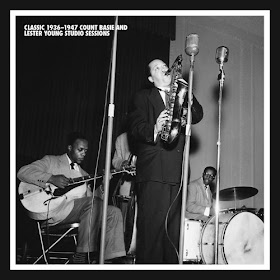BY THE TIME LESTER YOUNG hit the studio in 1936 to make his first recordings, the 27-year-old already had developed a significantly original sound – no easy feat in an era when many original tenor saxophone voices were busily redefining jazz’s boundaries. Coleman Hawkins was a few years away from revealing his more mellow side, while artists like Ben Webster, Barney Bigard, the short-lived Chu Berry, and audacious Bud Freeman were emerging from the pack.
But Young was more different still, his rhythmic intensity dancing behind harmonically inventive solos rendered in a creamy voice. And he was helped, on this session, by a rhythm section so tight that they played as one person. The triumvirate of Count Basie, Jo Jones, and Walter Page packed a syncopated wallop in every bar they played even as their music seemed to stare at you through sleepy, half-lidded eyes.
“The first thing that you have to keep in mind as you listen to these four selections is that nothing like them had ever been heard before,” writes Loren Schoenberg, a jazz historian who also wields a mean tenor sax. “And in the young Lester Young there can be heard the reinvention of the tenor saxophone as well as the first recorded examples of a new vocabulary for jazz.”
If you grew up, as I did, listening to this session until you knew the solos by heart, it’s difficult to appreciate that perspective. Young’s work sounds the way jazz ought to sound and seems always to have sounded. But Mosaic’s new eight-CD set, “Classic 1936-1947 Count Basie & Lester Young Studio Sessions,” helps reassert the primacy of that particular session in a context that captures Young’s driving essence both in and out of various Basie ensembles – and there’s a bit of Lester-free Basie in there as well.
This set covers recordings made for the Aladdin, Bluebird, Brunswick, Columbia, Commodore, Decca, Keynote, Mercury, Philo, Signature, Victor, and Vocalion labels, but significantly doesn’t include significant sessions waxed between February 1939 and November 1940 – because they were included in Mosaic’s “Classic Columbia, Okeh, and Vocalion Lester Young with Count Basie (1936-1940),” issued in 2008 and now out of print. But you have that set, I suspect. Also missing are the essential but readily available sessions Young recorded with Billie Holiday.
But you’ve got 173 swinging tracks here, 34 of them alternate takes that offer a look at how Young put together a solo. Four of those alternates go with that opening session, a find that’s worth the price of the set. Then it’s off to the Decca sessions with Basie, those beautiful 1937-39 recordings that never grow old as the band – anchored by a rhythm section of guitarist Freddie Green, bassist Walter Page, and drummer Jo Jones – eases through such standards as “Jumpin’ at the Woodside,” “Blue and Sentimental,” and the oddly interrupted two-sider “Cherokee” and such nonsense as “Stop Beatin’ ‘round the Mulberry Bush” and “Mama Don’t Want No Peas an’ Rice an’ Cocoanut Oil,” the last two more than redeemed by Jimmy Rushing’s vocalizing and the band’s ability to make anything sound superb.
As Schoenberg points out, “the best Young performances come when there is a sympathetic pianist at the helm of the rhythm section,” and Basie was the first and probably greatest of several. He gets a little competition from Jess Stacy in a 1938 Benny Goodman session, when Goodman brought in Young and the rest of the Basie rhythm crew. Young is heard for a scant 16 bars on “Ti-Pi-Tin,” included here, which proves his versatility with other players.
Young isn’t part of the small-group set with Basie and his rhythm from early 1939, so it’s almost like a Music Minus One recording – you keep waiting for that solo horn.
Among the standout post-Basie sessions are Young’s recordings with Nat King Cole, in trio settings with bassist Red Callendar in 1942 and drummer Buddy Rich in 1946. The Kansas City
Seven featured Basie at the piano with Buck Clayton and Dicky Wells on trumpet and trombone in 1944; a week later, the ensemble returned with the agile Joe Bushkin on piano and Bill Coleman doing trumpet duty in a session with a windfall of alternate takes that give fascinating insights into Young’s way of thinking jazz.
Norman Granz supervised most of the sessions that comprise the last few discs of this set, putting Young in sympathetic ensembles with the best of the mid-40s players, including a young Sadik Hakim and an even younger Chico Hamilton, and the 1945 sessions reveal a slightly different Young, still top-form but always restlessly exploring his horn. But by the end of 1947, when this collection draws to a close, the essence of Lester no longer was there.
As with all of Mosaic’s collections, this one invites you to curl up with the program notes and follow Schoenberg’s delightfully opinionated (and very insightful) session-by-session, even track-by-track analysis. You’ll appreciate the solo work even more, and it sure sharpens your listening skills.
Classic 1936-1947 Count Basie & Lester Young Studio Sessions
Mosaic Records MD8-263
mosaicrecords.com

No comments:
Post a Comment